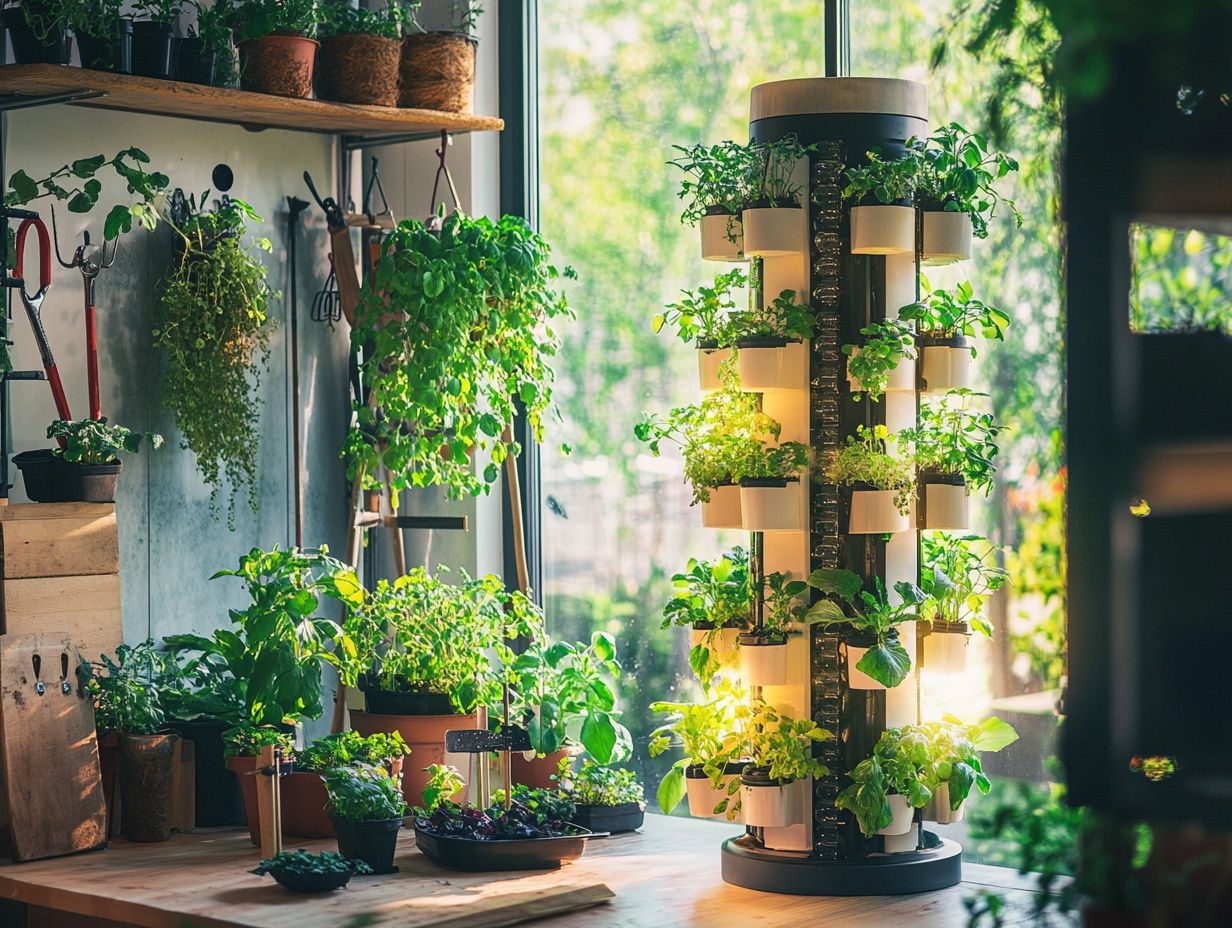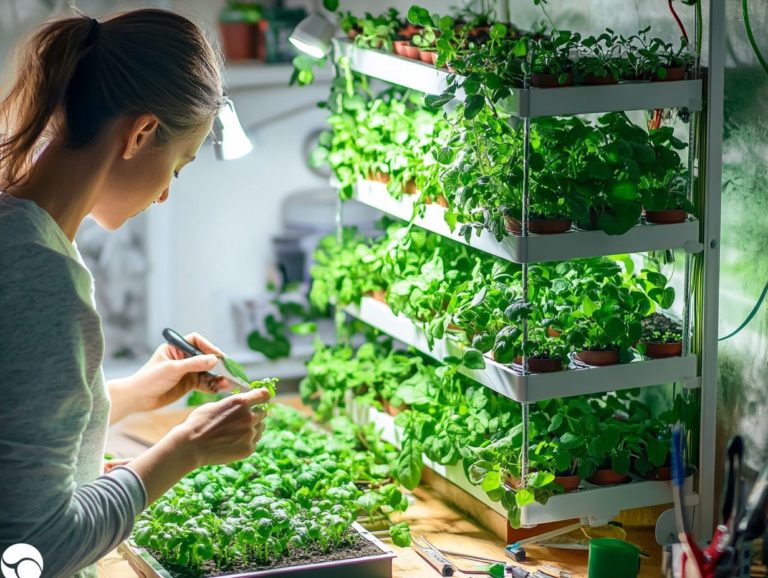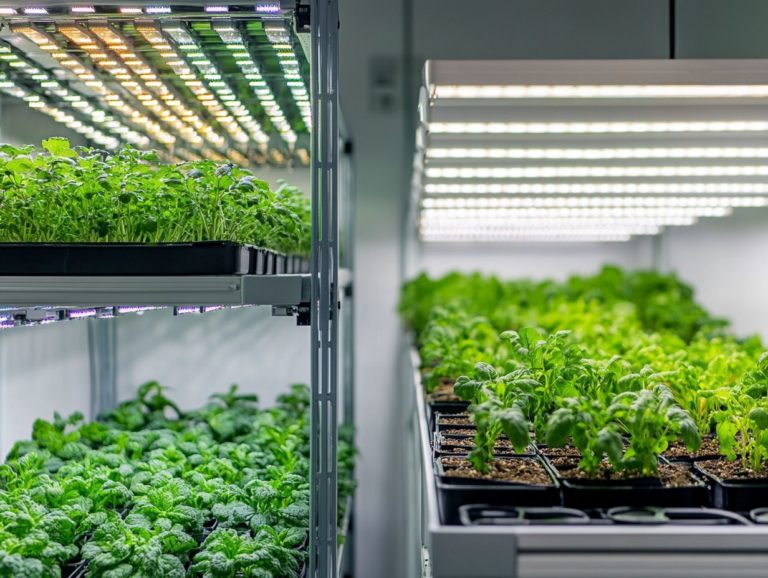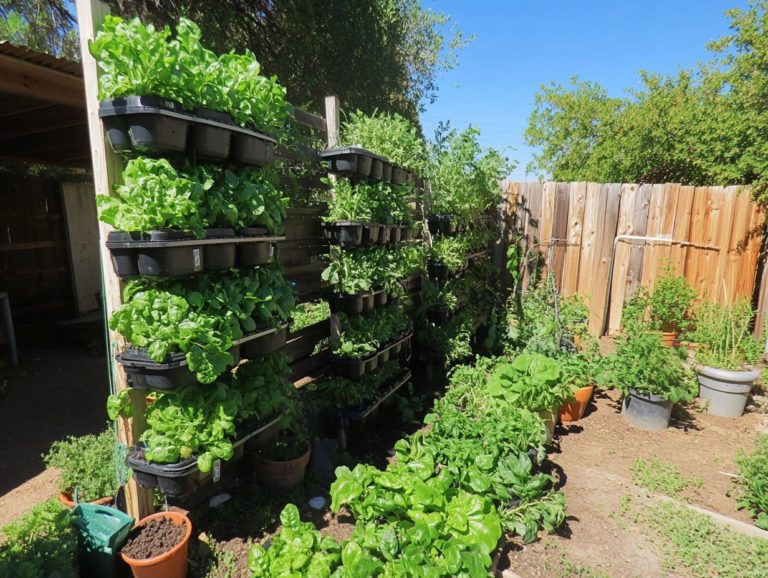10 DIY Hydroponic Projects for Sustainable Living
Are you enthusiastic about growing your own fresh produce but find yourself constrained by limited space or poor soil quality? Hydroponic gardening presents an innovative solution, enabling you to cultivate plants without the need for traditional soil.
Dive into ten captivating DIY hydroponic projects, ranging from straightforward mason jar herb gardens to sophisticated aeroponic systems.
Uncover the myriad benefits of hydroponics, explore how it supports sustainable living, and gather essential tips for getting started.
Embark on this transformative journey to elevate your gardening experience!
Contents
- Key Takeaways:
- 1. Mason Jar Herb Garden
- 2. PVC Pipe Vertical Garden
- 3. Hanging Bottle Garden
- 4. Window Farm
- 5. Floating Raft System
- 6. Bucket Drip System
- 7. Tower Garden
- 8. Aeroponic System
- 9. Nutrient Film Technique (NFT) System
- 10. Ebb and Flow System
- How Does Hydroponics Work?
- How Can Hydroponics Help with Sustainable Living?
- What Are the Common Challenges of Hydroponic Gardening?
- How Can One Get Started with DIY Hydroponics?
- Frequently Asked Questions
Key Takeaways:

- Save space and grow fresh herbs with a mason jar herb garden.
- Transform PVC pipes into a vertical garden for a unique and sustainable gardening solution.
- Upcycle plastic bottles to create a hanging bottle garden, utilizing innovative hydroponic methods.
1. Mason Jar Herb Garden
Creating a Mason Jar Herb Garden is a brilliant way to dive into hydroponics. This method allows you to grow fresh herbs indoors while maximizing space and supporting sustainable farming practices.
This compact system harnesses nutrient-rich water to nourish your plants, making it ideal for urban farming enthusiasts like you who desire a straightforward setup for home gardening no soil required.
Imagine cultivating a mini herb haven right on your kitchen counter with a delightful assortment of herbs like basil, mint, cilantro, and parsley. To embark on this green journey, gather the essential materials required for your hydroponic garden:
- Glass Mason jars for your easy setup.
- Potting media such as pebbles or clay pellets.
- Special liquid food for plants.
- A small bag of activated charcoal to keep your water fresh.
- A pair of scissors for trimming.
Once you re all set up, maintaining optimal growing conditions is key. You’ll need to keep an eye on the water level, ensuring it stays consistent, and provide ample light preferably from a sunny window or an LED grow light, as good lighting is crucial for plant growth.
With a little care, your herbs will flourish, giving you fresh ingredients for your next meal!
2. PVC Pipe Vertical Garden
A PVC Pipe Vertical Garden is your ticket to maximizing growing space. This setup allows you to cultivate an array of vegetables in a hydroponic system that s both compact and energy-efficient.
This innovative take on vertical farming harnesses water pumps and nutrient solutions to deliver optimal nutrients straight to the roots, boosting plant growth and enhancing crop yields.
Setting up this garden involves several thoughtful steps, starting with gathering your materials: PVC pipes, end caps, a water pump, tubing, and plant net pots. You ll also need essential tools like a drill, saw, and measuring tape for constructing the setup.
Once you ve assembled the structure, angle the pipes just right, fill them with your chosen growing media, and connect the pump for a seamless irrigation system. The benefits of this setup are plentiful: it conserves water, minimizes soil-borne pests, and promotes faster growth, allowing you to relish fresh produce even in limited spaces.
3. Hanging Bottle Garden
A Hanging Bottle Garden is a brilliant gardening project that allows you to transform recycled plastic bottles into a hydroponic garden system perfect for indoor gardening enthusiasts like yourself.
This innovative setup not only champions water conservation but also provides an engaging way for you to grow plants like strawberries and basil in limited spaces.
By repurposing everyday materials, you can create a unique display that thrives in vertical arrangements, making exceptional use of walls or balconies. To establish this system, simply cut the bottles, fill them with nutrient-rich growing medium, and carefully select plants that are well-suited for these environments. Alongside strawberries and basil, delightful herbs like mint and cilantro often flourish in these conditions.
This method also offers many benefits, such as minimizing waste and enhancing air quality, all while putting fresh produce and healthy options right at your fingertips.
Start your hydroponic journey today and enjoy the fruits of your labor!
4. Window Farm
Imagine turning your windowsill into a lively garden filled with fresh herbs and vegetables! A Window Farm is an ingenious indoor farming solution that allows you to transform your space into a thriving hydroponic garden, giving you access to fresh produce all year round.
This innovative approach utilizes nutrient solutions and grow lights to create optimal growing conditions for various herbs and vegetables. It s perfect for urban dwellers with limited gardening space.
Setting up this system is straightforward. You only need a few simple materials, including lightweight containers, a water reservoir, a water pump, and nutrient-rich solutions.
Choosing the right plants is crucial. Opt for those that thrive in hydroponic conditions, such as basil, mint, lettuce, and small cherry tomatoes.
The advantages of indoor gardening go beyond just enjoying fresh produce. It offers a fulfilling hobby, enhances air quality, and brings a touch of nature indoors, creating a serene ambiance in your living space while promoting sustainable farming practices.
5. Floating Raft System
Dive into an exciting hydroponic adventure with the Floating Raft System! This exceptional method enables you to cultivate plants in a nutrient-rich water environment, supported by rafts floating gracefully on the water’s surface.
This system optimizes nutrient uptake, offering an efficient way to grow vibrant leafy greens and aromatic herbs while conserving precious resources.
To start, gather a few essential materials. These include Styrofoam sheets for creating rafts and a water reservoir.
- Styrofoam sheets for creating rafts
- a reservoir for water
- a blend of hydroponic nutrients
Start by cutting the Styrofoam into appropriate sizes to create rafts that will cradle net pots, which house the growing medium. Once your rafts are ready, place them on a water reservoir filled with nutrient solution, allowing plant roots to dangle and effortlessly absorb vital nutrients directly.
This method offers significant advantages. It uses less water and requires minimal space, making it a sustainable choice for modern farming practices. Embracing the Floating Raft System positions you at the forefront of innovative cultivation techniques that not only enhance growth but also promote environmental stewardship.
6. Bucket Drip System

The Bucket Drip System is a reliable hydroponic solution. It delivers nutrient-rich water directly to plant roots, granting precise control over growing conditions.
At the heart of this system are individual buckets, each equipped with a drip emitter and a nutrient reservoir. You will also need flexible tubing and an air pump to maintain oxygen levels.
Utilizing a bucket drip system comes with a plethora of benefits. It conserves water, minimizes the risk of over-watering, and allows you to tailor nutrient delivery according to your plants specific needs.
For those embarking on this journey, managing nutrient solutions becomes vital. Regularly checking pH levels and adjusting concentrations can lead to thriving plants and bountiful harvests.
7. Tower Garden
A Tower Garden is a revolutionary vertical farming solution that maximizes space and allows you to grow a diverse array of plants in a hydroponic system, which is a method of growing plants without soil. This compact design uses new technology to deliver nutrient-rich water directly to your plants, ensuring optimal growth and a year-round supply of fresh produce. Don’t miss out on the chance to grow your own fresh produce start today!
By utilizing a vertical layout, the Tower Garden saves space and enhances accessibility, enabling you to tend to your plants with ease. You ll find that various plants, from vibrant herbs to leafy greens and even flowering vegetables, thrive in this setup, making it perfect for anyone eager to cultivate fresh produce at home.
Ready to dive in? Start by finding a sunny spot! Then, assemble the components, fill the system with water and nutrients, and plant your favorite selections. With straightforward steps and rewarding results, this endeavor becomes an engaging project for families and individuals alike.
8. Aeroponic System
The Aeroponic System is an advanced hydroponic technique that allows you to suspend plant roots in air and mist them with a nutrient solution to promote rapid growth and impressive yields. This innovative method leverages efficient farming practices, making it a fantastic choice for cultivating a variety of crops, including herbs and vegetables, even in limited spaces.
To set up this system, you ll need essential materials like a sturdy frame to support the plants, a misting mechanism to deliver the nutrient solution, and a reservoir to store this mixture. It s wise to use a timer to regulate misting intervals, ensuring the roots receive just the right amount of moisture without becoming waterlogged.
Beyond maximizing space, this technology allows you to reduce water usage and minimize pest issues, making it an eco-friendly option and a highly effective way to enjoy home gardening and indoor gardening throughout the year.
9. Nutrient Film Technique (NFT) System
The Nutrient Film Technique (NFT) System is an elegant hydroponic method that employs a continuous flow of nutrient-rich water over your plants’ roots. This creates optimal conditions for growth and nutrient absorption. This approach is especially effective for cultivating fast-growing crops like strawberries and basil, offering a sustainable solution for discerning home gardening enthusiasts.
Typically, an NFT system features a sloped trough or channel that supports the plants above a reservoir filled with nutrient solution, allowing the roots to absorb water while any excess drains back into the reservoir.
As you embark on building your NFT system, begin by selecting a suitable location with ample light. Then, gather essential materials such as PVC piping and a reliable water pump.
Plants like lettuce, herbs, and strawberries flourish in NFT setups due to their shallow root systems and rapid growth cycles, making them perfect choices for anyone wanting to maximize their crop yield efficiently.
10. Ebb and Flow System
The Ebb and Flow System is your go-to hydroponic gardening technique that masterfully floods a grow bed with nutrient solution at intervals. This ensures effective water conservation while promoting optimal plant growth. This method is a favorite among hydroponic enthusiasts due to its simplicity and effectiveness, particularly for crops like root vegetables, tomatoes, and herbs.
By employing a timer, pump, and drainage system, you ll establish a cycle of saturation and drainage that fosters robust root development, crucial for plant health.
Essential tools for your hydroponic garden setup include:
- A growing tray, suitable for growing vegetables,
- A reservoir to hold the nutrient solution,
- A pump to circulate the water,
- A timer to regulate the flooding intervals.
To achieve the best results, keep a close eye on the pH levels and nutrient concentrations, adjusting them as necessary to ensure your plants thrive in their growing conditions. Regularly checking for clogs and fine-tuning the flood duration will enhance the system’s efficiency, ultimately leading to a bountiful harvest.
How Does Hydroponics Work?
Hydroponics is an innovative method that allows you to grow plants without soil. Instead, it uses liquid mixtures that provide plants with essential minerals delivered straight to the roots. This technique ensures efficient nutrient uptake and optimizes plant growth.
With hydroponics, you can enjoy year-round cultivation and fresh produce. You can maximize crop yields and achieve significant water savings compared to traditional soil-based gardening methods.
By carefully crafting nutrient solutions, you can customize the minerals and vitamins that your plants need at different stages of their development. This results in healthier and more vigorous crops in your hydroponic project. In hydroponic systems, water serves as a crucial medium, providing hydration while also facilitating the direct delivery of essential nutrients to the roots.
Managing oxygen levels in the root zone is vital. It supports respiration and influences the overall health of your plants within your compact system. Hydroponics is also a sustainable solution for food production, as it reduces land usage and minimizes reliance on pesticides. If you’re looking to enhance your hydroponic setup, consider exploring 5 unique hydroponic systems to try this year. This contributes positively to the environmental impact.
What Are the Benefits of Hydroponic Gardening?

Get ready to discover the amazing benefits of hydroponic gardening! This method allows you to cultivate healthy produce in a sustainable way while significantly reducing resource usage. By mastering hydroponics, you can optimize your gardening techniques for impressive crop yields, all while minimizing the environmental footprint associated with traditional farming. It’s an appealing choice for the modern gardener.
By relying on nutrient-rich water solutions instead of soil, you’ll enhance plant health and promote faster growth rates. This enables you to enjoy multiple harvests throughout the year with your DIY hydroponic system. Additionally, exploring innovative hydroponic growing technologies can optimize your setup. This controlled environment also reduces the necessity for harmful pesticides, leading to cleaner and safer food options for your home produce.
Embracing this approach satisfies the rising demand for fresh produce and champions sustainable farming practices that conserve water and minimize land usage. In doing so, you help pave the way for future generations to adopt eco-friendly agricultural methods and urban farming.
What Are the Different Types of Hydroponic Systems?
Regarding hydroponic systems, you ll discover a variety of options, each with unique advantages and methods for efficient farming, including vertical farming. From the Nutrient Film Technique (NFT) to Ebb and Flow and even aeroponic systems, understanding these methods will help you select the best approach for your gardening needs.
Each system operates on distinct principles tailored to various crop types and environmental conditions. This ensures that every gardener can find the right fit for their gardening projects. For example, the NFT system continuously circulates a thin film of nutrient solution over the roots in a sloped trough, making it particularly well-suited for fast-growing leafy greens like kale and lettuce. If you’re just starting out, consider exploring 5 hydroponic systems for beginners on a budget to get started.
In contrast, the Ebb and Flow system floods the root zone with nutrient-rich water before draining it away, which is ideal for a broader range of crops, including tomatoes and peppers for your hydroponic garden.
If you re looking for something even more advanced, aeroponic systems mist the roots with a fine nutrient solution. This promotes faster growth while using minimal water, making it a top choice for creative gardening. This method is perfect for high-value crops such as herbs and strawberries, highlighting the versatility of hydroponic techniques.
Start your hydroponic journey today for fresh produce all year round!
How Can Hydroponics Help with Sustainable Living?
Hydroponics is a game-changer in sustainable living. It allows you to reduce water usage, cut down on pesticides, and enjoy fresh produce all year round with an easy setup.
This method shines particularly in urban settings, where space and resources can be a challenge. It s the perfect choice for eco-conscious gardeners like you who value energy efficiency.
Using nutrient-rich water instead of soil offers huge water conservation benefits. You can save up to 90% less water compared to traditional farming methods, a significant advantage in urban farming.
Imagine cultivating food in controlled environments that dramatically reduce land use. You can turn vacant lots and rooftops into thriving green spaces with the help of vertical farming techniques.
Growing food locally doesn t just shorten the supply chain and minimize carbon footprints; it also bolsters food security within your community, ensuring fresh produce is always accessible.
What Are the Common Challenges of Hydroponic Gardening?
While hydroponic gardening has many benefits, it also comes with its share of challenges. These include managing nutrient solutions, ensuring proper pH levels, and preventing plant diseases especially if you re just starting your hydroponic project.
By acknowledging these hurdles, you can effectively navigate the fascinating world of hydroponics. Implement strategies for a flourishing garden using effective gardening tips.
Achieving the right nutrient balance is essential. Opting for a reliable hydroponic nutrient mix tailored to your specific plants can lead to remarkable results in your DIY hydroponics setup.
Regularly monitoring pH levels with straightforward testing kits will help you avoid nutrient lockout, which occurs when plants can’t absorb nutrients due to improper pH levels. This ensures your plants receive all they need for optimal growth.
To fend off diseases, adopting good hygiene practices like cleaning your equipment and using sterilized growing media can be invaluable for your hydroponic garden.
Educating yourself about common pests and their prevention methods will enable you to maintain healthy, thriving plants in your hydroponic setup, ensuring successful indoor gardening.
How Can One Get Started with DIY Hydroponics?
Starting a DIY hydroponics journey is an exhilarating endeavor. It enables you to establish your own hydroponic system at home, delivering fresh produce while reveling in the joys of indoor gardening.
It requires a thoughtful approach: understanding the project steps, gathering essential materials, and selecting the right plants to ensure optimal results.
For those just starting, it’s crucial to break the process into manageable phases to streamline your DIY hydroponic efforts. Begin by researching various hydroponic methods, such as deep water culture or nutrient film technique, to find the one that best suits your space and aspirations. You might also consider building a vertical hydroponic garden at home for efficient space utilization.
Next, gather the necessary equipment, which may include a water reservoir, pump, net pots, and nutrient solution. Ensure you have the right tools like a drill, scissors, and a pH meter to streamline the assembly process. For those interested in starting their own setup, check out these DIY hydroponic system plans for beginners.
As you start this exciting project, keep in mind the importance of proper lighting, like grow lights, and airflow. Regularly monitor water levels and meticulously track your plants growth to refine your technique, paving the way for a bountiful harvest of healthy produce.
Frequently Asked Questions
What is hydroponics and how does it promote sustainable living?

Hydroponics is a method of growing plants without soil, using water and nutrient solutions instead. This promotes sustainable living by conserving water and using less space while also producing healthy and pesticide-free plants.
What are some benefits of building your own DIY hydroponic project?
Building a DIY hydroponic project saves money and boosts your self-sufficiency. You gain control over the quality of your produce and can customize the system to fit your space.
What materials do I need to get started?
You’ll need containers, a water pump, grow lights, growing medium, and nutrient solutions. The specific materials can vary based on your chosen method.
What are some beginner-friendly projects?
Start with simple projects like a nutrient film technique system, a mason jar herb garden, or a PVC pipe vertical garden. These require minimal materials and are easy to set up!
Are there eco-friendly alternatives?
Yes! Use recycled materials for containers and organic nutrient solutions. Incorporating solar power for lighting is also a fantastic eco-friendly option.
What types of plants can I grow?
With DIY hydroponics, you can grow herbs, leafy greens, vegetables, and even some fruits. Popular choices include lettuce, tomatoes, strawberries, and peppers!






